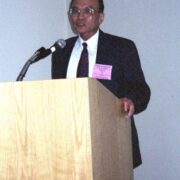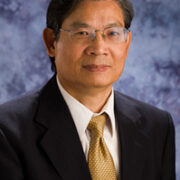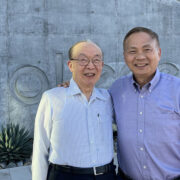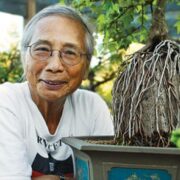From Basic Medicine to Pathology: Reflections on 40 Years in the United States
By: Ching Yung Lee 李慶榮
When I was an undergrad medical student I was very interested in physiology, so I decided to pursue higher education in the United States after graduating. After serving as a resident doctor at National Taiwan University (NTU) Hospital Pediatrics Department for one year, I’d accumulated enough travel funds and applied to intern at a hospital in New York City. I was brimming with enthusiasm for research and future ideals, so after completing one year of internship I decided to return to school as a graduate student, beginning my career in basic medicine.
Dissertation in Physiology
I was accepted into the Department of Physiology at Vanderbilt University in Tennessee. With my scholarship as a research assistant I worked part time and studied part time. Though I lived frugally, my wallet was still empty after paying tuition. A year later I transferred to the Department of Physiology at University of Michigan and my situation improved substantially. The annual salary for a research assistant was $3,600; life was comfortable and the teaching burden was light, so I could concentrate on my studies. At Vanderbilt University I had taken classes with two authoritative professors from the physiology and biochemistry departments (Dr. Earl W Sutherland and Dr. Stanley Cohen). Sure enough, their fame was well-deserved. They each received Nobel prizes in 1977 and 1986, respectively.
The University of Michigan is located in the peaceful and quaint small town of Ann Arbor in southern Michigan. Of the dozen or so grad students in the Department of Physiology, I was the only international student. I was excited when Dr. Nai-shin Chu 朱迺欣 arrived from off campus after my first year. I also had friends from other departments like Dr. Tianshun Li 李靝順, Dr. Chinlong Wang 王金龍, and Professor Tsungyi Lin 林宗義 and his wife. There were many Taiwanese students at University of Michigan; together we went on outings to the country, played baseball and badminton, ate and discussed the joys of student life. One Taiwanese student I met was a physics grad student called Weihua Lin 林偉華 – we learned much from each other and fell in love, later marrying at a church in Ann Arbor. My physiology classmates put on an end of bachelorhood party before the wedding and I formerly parted from my time as a bachelor. After getting enough credits to pass the written and oral examinations I received my doctoral degree in 1970. My wife also got her Ph.D. in physics. The birth of our two sons is my happiest memory in life.

I remember president Siliang Qian 錢思亮once said, “Getting a Ph.D. is the beginning of being a scholar.” After graduating from the University of Michigan, I decided to remain in academia and do research. I applied for research allowances from the obstetrics departments of Harvard and the University of Pennsylvania, focusing on clinical research. But I was most impressed by the department of endocrine research at Mayo Clinic and their focus on research of basic medicine. In the end I accepted the Endocrine Fellowship from Mayo Clinic. The allowance came from the National Institute of Health (NIH). In June of 1970 we sorrowfully left our beloved Ann Arbor by car.
Mayo Clinic Basic Medicine Research
Mayo Clinic is a world-famous clinic located in a small town in southern Minnesota. In the winter, snow can pile up to several meters, snow and ice all around. I remember there were over 500 resident physicians at the hospital – you can imagine what a huge organization it is. The Endocrine Department was renown across the States, with 30 experts in endocrinology, a strong line-up. President Bush Senior and his wife once sought help at the thyroid clinic. To meet needs for basic endocrine research, Mayo Clinic set up a separate Department of Endocrine Research. Most of the professors in the department were experts in the endocrine system and rarely saw patients, focusing on their research. The endocrine clinic and Department of Endocrine Research were intimately connected, holding periodic academic discussion groups at the stately Mayo Foundation House. After the discussion there was a plentiful formal meal, and even cigars afterwards. The Director of the Department of Endocrine Research Dr. A Albert had an M.D. and Ph.D. from Harvard. He placed me in the laboratory of Dr. Robert Ryan. Dr. Ryan used to be a professor if internal medicine at the University of Illinois, famous for his research in LH (Luteinizing Hormone) and FSH (Follicle Stimulating Hormone).
My classmate Dr. Tsunching Kao 高村井, and older alumni Dr. Fuhsiong Shen 沈富雄, Dr. Wenbo Su 蘇文博, and Dr. Manmei Li 李滿美and his wife, as well as Dr. Chunhong Hu 胡俊宏 who graduated from Taipei Medical College, were also resident physicians at Mayo Clinic at the time. Alumnus Dr. Chinshi Wang 王金石was the attending physician of the anesthesiology department. My wife was a post-doc fellow in the physiology department, researching three-dimensional cardiac reconstruction.
In the 1970’s, research in hormone receptors was just budding; estrogen and insulin receptors were discovered one after the other. I hypothesized that ovaries had LH and FSH receptors. After consulting with Dr. Ryan, I began my research in this direction. Dr. Ryan had already set up a radioimmunoassay for LH, FSH, and HCG
receptors. Out of convenience I used the 131 I-LH and 131-HCG that we had on hand. Because we did not know if the receptors were on the membrane or inside of the cells, we used fresh ovarian slices as the receptor sites.
Research is seldom successful from the get-go. For the first three months we had no results and I felt disappointed. One day, the radioactivity was too low on the 131 I-HCG that a technician prepared, and it was not suitable to use with radioimmunoassay The discarded hormone was given to me for my receptor research. I remember that evening there was an Endocrine Research Seminar at the Mayo Foundation House, and after the seminar was over I returned to the lab to look at the results. Contrary to expectation, the radioactivity of the ovarian slices was several times higher than that of other organ slices (liver, spleen, kidney etc), indicating that the ovaries had HCG receptors. At that moment I suddenly realized that the molecular structure of the radioactive HCG we had used before had broken down during iodination, so that it could not bind with the receptors. This was a turning point in my research. After this we changed to mild radioiodination and the experiments proceeded smoothly. I experienced excitement at first discovering LH receptors, that sense of how research relies on luck, but luck relies on preparedness.
Presenting a Paper at the Endocrine Society
The 1971 conference of the Endocrine Society was held in San Francisco. I presented my findings on LH receptors at the annual conference, eliciting substantial interest and attention. I continued to present papers at the conference in the following years and published several consecutive papers in medical and scientific journals. Because LH and HCG have similar chemical structures, they share a common receptor, while FSH has a different receptor. LH and receptors bond and separate with the same chemical reaction – you can use physiochemical calculations of equilibrium dissociation constant, number of binding sites, association rate, and dissociation rate constants. I presented all these findings in professional journals, and later also proved that ovaries also have FSH receptors. Additionally, I was the first to prove that the thyroid has TSH (thyroid stimulating hormone) receptors. Letters requesting printed copies of the papers flooded in – besides Europe and the Americas, they also came from Japan, Australia and Eastern Europe. My notable research success earned me a Mayo Clinic Distinguished Alumni Award. It was specially sent to me on my birthday, and not long after I was promoted to assistant professor.
Invited to Speak at an International Conference
In 1972, the NIH held an international academic conference with a topic of receptors for reproductive hormones. The location was Tennessee Vanderbilt University. The participants were restricted to invited famous scholars from around the world. Those from the U.S. included University of Chicago biochemistry professor Shutsung Liao 廖述宗 (a graduate of NTU) and Dr. EV Evans. From the UK came Dr. R JB King and others, and from France came Dr. E E Baulieu and others. Dr. Ryan and I were honored to be invited to participate as well. Returning to Vanderbilt after several years had a sweet sense of familiarity. Research in estrogen and androgen receptors was flourishing at the time – presentation topic largely focused on this, 16 in total, while LH and FSH receptors had only been discovered for three years; only four presentations covered them. My presentation topic was Luteinizing Hormone Receptors in Luteinized Rat Ovaries.
With rich content exceeding the 45 min time limit, Dr. K J Catt of the NIH lectured on LH receptors in the testes. Because LH receptors were a comparatively fresh topic, it caught the attention of many attendees. There were not many participants in the conference and discussion was lively. We quickly got to know each other and built rapport. After the conference, a special compilation of papers was published, titled Receptors for Reproductive Hormones. Dr. Ryan and I represented Mayo Clinic, and Dr. Catt of the NIH was considered an authority on LH receptors. I was flattered to share the stage with international scholars for the first time.
The Endocrine Society held its 1974 conference in Mexico City, and I was invited to be the moderator of the hormone receptors group. Yet Mexico and Taiwan did not have diplomatic relations, and I was refused entry due to my Republic of China passport. I had no choice but to ask an American colleague to represent me.
Presenting at an International Conference in Italy
In the spring of 1975, I received a letter from VHT James, Chairman of Serono Symposium, inviting me to participate in a week-long international conference in Florence, Italy. The conference topic was Endocrine Function of the Human Ovary. I was invited because Dr. Ryan and I had first discovered human ovaries had LH receptors. Return tickets as well as room and board were all covered by IF Serono. Dr. S C C Yen of the University of California also flew from the States. Other international scholars came from England, France, Italy, Western Germany, Sweden, and Belgium, etc. The audience of several hundred in the grand conference room didn’t have the intimate feeling of my last international conference. My presentation topic was Specific Binding of HLH and HCG To Ovarian Receptors. A compilation of papers was published under the title of the conference.
Discovering LH Receptors in Human Ovaries
When I first started experiments on LH receptors, I used luteinized ovaries. Later, I hypothesized human ovaries also had LH receptors, but my experiments went through a rocky time because human ovaries are hard to acquire, and the time of delivery was always afternoons – working on animal experiments during the day I couldn’t stop in mid track. I had no choice but return to the lab after dinner. One day the delivered ovaries happened to have several fully developed corpus luteum; this was an opportunity I could not pass up. My experiment took from evening till daybreak, and it was successful. As I drove home in dawn light, my body was weary but I felt very excited, because I was the first to have concrete proof of LH receptors in human ovaries. I continued my evening experiments for a year and proved the number of binding sites for LH receptors was related to ovarian function. I published my paper on human ovaries in the Journal of Clinical Endocrinology.
Applying for Research Stipend and Award from the NIH
My stipend for my first three years at Mayo Clinic came from the NIH fellowship, about $8,000 a year. Our family of four lived in the dormitories and led a simple and comfortable life. When my fellowship was up, Dr. Ryan asked me to apply for an NIH research stipend to serve as part of my income. Thanks to my hard work day and night leading to my research results and discovery of LH receptors, I received an NIH research stipend for the first time in 1973. It would last three years and was worth $20,000 in total. Dr. Ryan and I were the co-principle investigators, additionally requesting an NIH research contract related to LH receptors worth $60,000 over three years.
After another year Dr. Ryan suggested I apply for the NIH Research Career Development Award, an award helping goal-driven young people to carry out research. The award would last 5 years and cover all living expenses. Not worrying about living expenses for five years was the dream life for young researchers. I was honored to pass the NIH examinations, however, in 1974 the US economy was in bad shape and NIH budget was shelved by the Whitehouse (this was during the Nixon administration). My award seemed to be suspended out of reach, gone. This sudden threat woke me up to the reality that I could not just rely on research stipends to raise my family; it also made me lose faith in the government’s support of research. Later, the NIH budget was passed and my award was approved, but by this time I had long since left Mayo Clinic.
My Career as a Resident Physician of Pathology and Professor
For the past ten years I’d focused all my energy on basic medicine, and neglected the need to obtain a medical practitioners license. I needed a fresh start for my future, so I resolved myself to take the exam to get my license. It felt unfamiliar to leave the clinic after all these years, but fortunately I had my classmate Wenbo Su 蘇文博 to give me some pointers (he’d passed the exam not long ago). Days melted into nights. I left home early and returned late; besides doing experiments I also concentrated on preparing for the exam, and finally received my medical practitioners license. My daughter, not yet a year old, had not seen me for months, and didn’t even recognize her own father. This made me feel shocked and guilty. When I received my license, Dr. Ryan worried I would leave and offered a raise; Mayo Clinic promoted me to be a consultant (attending physician), but I had already decided I could not remain and continue research. In 1975 I accepted an offer from the University of Minnesota to be a resident physician of pathology and assistant professor.
I was not willing to give up five years of fruitful research, so I decided to transfer my research funds and equipment to the University of Minnesota to continue my research. The installation of all the equipment in the new laboratory was a grand sight. I also began to hire lab technicians. The director of the Department of Pathology Dr. Elis Benson encouraged me to again apply to the NIH Research Career Development Award. Because my application had already been accepted, once NIH had their budget, they approved a $19, 000 award. I was honored. The university magazine and World Journal both announced my award.
With my dual employment as a college professor and resident physician, I was even more stretched than at Mayo Clinic, and was hardly ever home. Fortunately, my wife was understanding. On Sunday afternoons she brought the kids to the lab to see me. From my lab you could see the Mississippi River opposite – we would take the kids on walks by on river bank to play. They were thrilled to catch little fish in the water. These were moments of joy in my busy life. At the university my classmate from NTU Dr. Richia Liao 廖日嘉was a professor in the Department of Anesthesiology – we often visited his home on weekends. NTU alum Dr. Tsengguang Chen 陳增光was in my own department.
My income came from my five-year research award; when the term was almost up I had to re-apply. I was bursting at the seams. Dr. Benson allowed me to temporarily stop my work as a resident physician for three months so I could concentrate on applying for the research award. Fortunately I was honored to receive the NIH research award for a second time, lasting three years and worth $96,000 in total. When my clinical pathology training was complete, I successfully passed the exam of the American Board of Clinical Pathology. I had only completed clinical pathology training, but out of research interest I later transferred to the Albany Medical Center in New York to train on anatomic pathology. Albany is the capital of New York State, and Albany Medical Center has a 150-year history. There I served as a resident physician while also serving as an assistant professor in the Department of Biochemistry, researching together with Dr. L Reichert. After my two-year residency was up, the East Tennessee State University Medical Institute hired me as a Professor of Pathology. After one year, I returned to Albany to take the exam from the American Board of Anatomic Pathology. I have served at the veteran’s hospital and as a professor of pathology at the Albany Medical Institute for almost 20 years.
Lecturing at Beijing Medical University
In 1983, my classmate from NTU Dr. Haochia Chen 陳浩佳sent a letter inviting me to give lectures in Beijing on the topic of hormone receptors and chemistry. This was part of Sino-US Scientific Cooperation Exchange Program jointly organized by the NIH and Beijing Medical University. The lead organizer from the US was Dr. Haochia Chen, an outstanding biochemist at the NIH. The main organizer from the other party was Weihsiong Li 李偉雄, Director of the Chinese Fertility Research Institute, a kind person who often came to Europe and the US for survey trips. The return plane tickets for myself and Dr. Chen were taken care of by the US government, and the Chinese government took care of transportation and room and board. Before the trip Dr. Chen carved time out of his busy life to prepare the teaching material and equipment for the experiments. I truly admire him for his serious commitment to all he does. The lectures went on for four weeks, 40 hours of class in the mornings and 60 hours of experiments in the afternoons. There were 60 scholars in all, including 16 doctors and university researchers. Aside from Beijing, paarticipants also came from Shanghai, Fujian, Guangdong, Chongqing, Wuhan, Shenyang, and Harbin. They were incredibly serious in their studies. When the lectures were over, I toured the Great Wall, Xi’an, Hangzhou, Guilin, and Guangzhou, before passing through Hong Kong on my way to see relatives in Taiwan.
Pathology, Teaching, and Research
At Albany Stratton VA Medical Center I was responsible for clinical chemistry and research, and took turns doing diagnoses with the electron microscope, primarily for kidney puncture and tumors. Our electron microscope center served a scope of over 20 hospitals in northern New York State and western Massachusetts. In 10 years of experience I have encountered many difficulties and cases of interest; I have benefited a lot. It’s a shame that our budget was not sufficient and not long ago we had to halt electron microscope diagnoses. My educational work includes training resident physicians of pathology, educating university students in pathology, and holding a class on electron microscopes for grad students in the summer. My colleague Anya Shi 施安雅in the Department of Pathology was a committed educator and won an Excellent Teacher Award. As for my research, NTU alum Dr. Minfu Cheng 鄭敏夫 and I cooperated to research the influence of interleukins and tumor ne-crosis factor on the toxicity of oxygen. I was responsible for examining lung tissue with the electron microscope and for general pathological changes. We collectively published near ten papers. Dr. Cheng and I also applied to a three-year research award worth $120,000, and I received an additional research award of $40,000. Dr. Cheng was very entrepreneurial in this area; it was a shame when he received a better employment offer and left Albany. I had done research together with my previous colleague Dr. James Dias, and through his introduction, I also served as a guest professor at the State University of New York (SUNY) Department of Biomedical Sciences.
Career and Family
The road of research is rugged and precipitous. It is a lot of pressure to just rely on research stipends to raise a family – it’s publish or perish, if you don’t publish enough papers and don’t receive research stipends, there goes your position. As an ambitious young person, I often ran experiments until late in the night, and often neglected my family. I was hardly at home and felt guilty for this. Fortunately, my wife was very understanding – it is thanks to her support and education of our children that we have such a beautiful family today. Our first two sons have already established families and careers: the eldest is a radiologist and the second is studying for a master’s in electrical engineering at Cornell University. Our daughter is a resident radiologist at Mount Sinai Hospital in New York City. Our youngest son is completing his undergraduate studies in dentistry at the University of Pennsylvania – his excellent grades have earned him a scholarship. After my wife got her Ph.D. in physics from the University of Michigan, she served as a post-doc fellow at Mayo Clinic, simultaneously looking after the children. While raising four children, she continued to work, employed by General Electric and Texas Instruments. She is currently doing research for the US Army Engineer Research and Development Center, cooperating with the nearby Rensselaer Company (RPI). Of the 100 or so papers the two of us have published in scientific and medical journals, several are a product of our combined efforts.
Final Reflections
I am fortunate to have been admitted to NTU Medical School, and am grateful to the care of my teachers and enrichment from my alma matter. After 40 years of hard work in the United States I have finally fulfilled my life-long hopes and dreams. I have a beautiful family; my children have completed their higher education and I am satisfied with all my heart, enjoying the pleasures of life. I would like to share some thoughts on my past research experience as reference for young doctors and medical students eager to do research. There are trials and joys doing research – no pain no gain. It requires interest and a strong resolve. Medical students should establish a foundation by taking advantage of their summers to go to intern and participate in research at the Department of Basic Medicine. Being a clinical doctor and taking care of patients is busy, but the benefit is that your income is guaranteed, and if you receive a research stipend you can do research on the side. These days, science is advancing with each passing day. It is best to cooperate with a professor of basic medicine – you can share in their strengths and have better results. If more young doctors invest themselves in basic medicine or clinical research, I guarantee the academic standards of NTU Medical School and NTU Hospital will improve to be on par with famous medical institutes of the United States, while also developing scientific knowledge and contributing to society.

Source: Dr. Ching Yung Lee, January 2016
Translated from: 397. 從基礎醫學到病理,留美四十年回顧 / 李慶榮 /2016/02 by Sky Ford
Posted 1/11/2021





